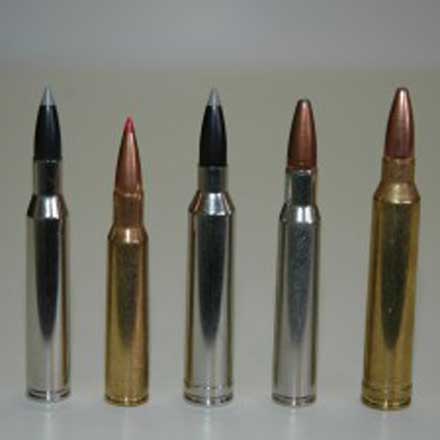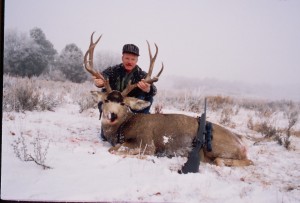
Roy Weatherby was a savvy gun guy. He was also a marketing genius and a true zealot who believed in his theories about high velocity and his own cartridges that produced them. In the postwar era, the belted cartridges that bore his name beganmaking serious inroads into the staid American firearms industry. He made the majors nervous, and they responded with their own cartridges bearing the suddenly popular “magnum” suffix. Winchester led the charge, first introducing the .458 Winchester Magnum in 1956, following in 1958 with the .264 and .338 Winchester Magnums. They completed their quarter of short magnums in 1963 with the .300 Winchester Magnum, all based on the .300 H&H case shortened to .30-06 length (nominally 2.5 inches), necked appropriately with body taper removed.
Before Winchester completed its family of short belted magnums, Remington, initiallyquiet, responded in 1962 with the 7mm Remington Magnum. In the decades that have followed, the public has spoken. The.458 Winchester Magnum, for a time the most popular big bore in history, has given way to the .416s and the .458 Lott. The .338 Winchester Magnum has become a world standard, but on a limited scale, asare all cartridges above .30 in caliber. The .300 Winchester Magnum has been a stunning success, effectively supplanting the time-honored .300 H&H, and, over time, becoming the most popular “fast .30,” and theworld’s second most popular magnum cartridge. Initially taking off like a rocket, the .264 Winchester Magnum was blown off the market by Remington’s “Big Seven.” I am personally a fan of the .264, at least for limited purposes, but I freely admit that the 7mm Remington Magnum's ability to use heavier bullets makes it considerably more versatile.I guess the majority of riflemen agree, because the 7mm Remington Magnum went on to become the world’s most popular belted cartridge, and the world’s most popular cartridge to bear the “magnum” moniker.
As a bullet diameter 7mm, .284-inch, has been a popular worldwide standard since the 7×57 Mauser hit the streets in 1892, one of the earliest smokeless cartridges still with us. The concept of a fast 7mm is also not new. The Canadian .280 Ross, a true rimless magnum, introduced in 1907, made quite a splash, but lagged because pre-World War I softpoints weren’t up to its high velocity. The .275 H&H, introduced in 1912, was never especially popular, but is suspiciously similar to the Remington cartridge...
that followed a half-century later. Roy Weatherby also had (and his company still produces) the 7mm Weatherby Magnum; both it and the .275 H&H were based on the .300 H&H case shortened, blown out, and necked down.

But it was in the 1950s as magnum fever gained impetus that the concept of a fast 7mm started to take hold. Designed by Americans Phil Sharpe and Richard Hart, but in Danish Schultz & Larsen rifles with Norma ammo (from Sweden), the efficient 7×61 Sharpe & Hart became a gunwriter’s darling. No less a star than Warren Page, longtime Shooting Editor of Field & Stream, spilled gallons of 1950s-vintage ink touting a fast 7mm, wildcat. The .280 Remington, essentially (and almost so named) 7mm-06, came along in 1957, but didn’t live up to its promise because initial loads were purposefully mild for use in Remington’s autoloaders. Today’s .280 loads are somewhat improved, and handloads will actually come very close to 7mm Remington Magnum performance. Even so, this cartridge has never been extremely popular. Five years later, seeing the growing popularity of the 7×61 S&H and 7mm Weatherby Magnums, and just possibly listening to Warren Page whispering in their ear, Remington brought out what would become their signature cartridge, the 7mm Remington Magnum, introduced in what would become their signature rifle, the brand new Remington Model 700.
The 7mm Remington Magnum was (and, to a lesser degree, still is) touted as one of the best “western” cartridges. It is indeed versatile. With fast and flat-shooting 140 and 150-grain bullets, it’s a fantastic open-country cartridge for mule deer, sheep, andgoat. With long-for-caliber, deep-penetrating 160 and 175-grain bullets, it is at least perfectly acceptable for elk, and Warren Page proved the effectiveness of the fast 7mm with heavy bullets on game up to Alaskan brown bear. Not everyone agreed. Jack O’Connor reckoned that with just .007-inch difference in bullet diameter, there wasn’t enough difference between the 7mm Remington Magnum and his beloved .270 to worry about. Elmer Keith, as one might expect, found it too light for large game, continuing to tout his signature fast...
.33s.

Me, well, I won’t be a hypocrite. If I want fast and flat, I figure O’Connor had it right; I prefer a .270. If I want more power, I have written many times that I firmly believe the ‘tired old .30-06’ hits harder, with more frontal area and more bullet weight, than the 7mm Remington Magnum. If I want more power and a flatter trajectory, I lean toward the fast .30s. For these reasons I am on record as not being a particular fan of the 7mm Remington Magnum. It is almost impossible for anyone to equally love all the cartridges between .270 and .30 caliber that, essentially, serve similar hunting purposes. I do not equally love them all, so with apologies to no one, the 7mm Remington Magnum falls pretty far down my list of personal favorites.
The many millions of 7mm Remington Magnum fans don’t necessarily agree, nor should they. Our preferred hunting weights of 7mm bullets, from 140 to 175 grains, tend to be long for caliber and offer superb penetration. The 7mm Remington Magnum, unlike the 7×57, 7mm-08, the .280, and even the 7×61 Sharpe & Hart, has enough case capacity to drive even heavy 175-grain bullet at meaningful velocity. Fairly standard today is a 140-grain bullet at 3175 fps; 150-grains at 3110; 160-grains at 2900; and 175-grainbullet at 2860 fps. Depending on your purpose, take your pick!
It is, perhaps, odd that I am not a huge fan of the 7mm Remington Magnum, becauseI’ve actually used it a great deal. The cartridge has been the chambering of some of my favorite personal rifles; I’ve used it extensively in Africa and North America, a bit in Asia and Europe, and it has accounted for some of my best, favorite, and most-prized trophies. I can honestly say that it has never, ever let me down! It has done for me what it has done for many hunters: sheep, goat, caribou, whitetail,mule deer, Coues deer, blacktail, the occasional black bear; African game up to kudu and zebra; ibex, chamois, red stag, and a whole lot more. Being a bit of a heavy-bullet guy, but loving velocity as
much as any other red-blooded American, most of the time I have compromised on 160 and 165-grain bullets. Only rarely have I used the heavy 175-grain bullet,...
but I have used lighter, faster bullets from 140 to 154 grains on several occasions. Performance has never been an issue.
Whether you love it, or, as I do, merely respect it, you must give the 7mm RemingtonMagnum its due. It is extremely versatile, offering fantastic performance at a veryacceptable price in recoil. These days, it has stiff competition from many other fast7mms, some shorter and fatter, others longer and faster. In fact, its market has been diluted so much that it appears to be slipping a bit in overall popularity. This is almost inevitable, but it still stands as one of our very best open-country cartridges, and whileit may not always remain the world’s most popular magnum, it will almost certainly continue to rank as the world’s most popular 7mm rifle cartridge.